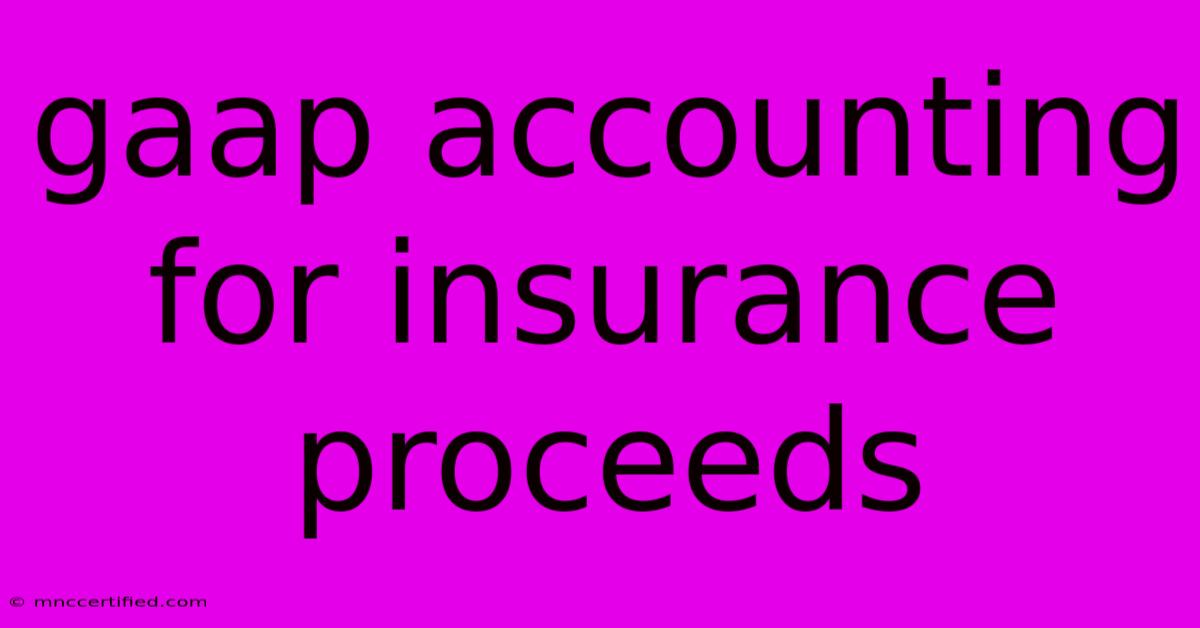Gaap Accounting For Insurance Proceeds

Table of Contents
GAAP Accounting for Insurance Proceeds: A Comprehensive Guide
Insurance proceeds can be a lifeline for businesses facing unforeseen events like natural disasters, accidents, or theft. But how do these proceeds get accounted for under Generally Accepted Accounting Principles (GAAP)? This guide will delve into the intricacies of GAAP accounting for insurance proceeds, helping you understand the relevant rules and ensure accurate financial reporting.
Understanding the Basics
Insurance proceeds represent the funds received from an insurance company to compensate for a covered loss. This compensation can be for various types of losses, including:
- Property losses: Damage or destruction of physical assets, such as buildings, equipment, or inventory.
- Liability losses: Legal obligations arising from negligence, accidents, or product defects.
- Business interruption losses: Loss of revenue or profits due to a covered event that disrupts business operations.
GAAP Accounting Principles for Insurance Proceeds
GAAP dictates specific rules for accounting for insurance proceeds. These rules ensure accurate financial reporting and prevent the manipulation of financial statements.
Here are the key principles:
- Matching Principle: Insurance proceeds should be recognized in the same accounting period as the related loss. This principle ensures that expenses are matched with the corresponding revenue or loss.
- Realization Principle: Insurance proceeds are recognized as revenue only when they are realized, meaning they are actually received or are deemed reasonably certain to be received.
- Cost Recovery Principle: The insurance proceeds are used to recover the cost of the asset that was lost or damaged. This means the insurance proceeds will be used to offset the loss, rather than being recognized as additional income.
Accounting for Different Types of Insurance Proceeds
The specific accounting treatment of insurance proceeds varies depending on the type of loss covered:
1. Property Losses:
- Partial Loss: If the insurance proceeds cover only part of the asset's value, the proceeds are recorded as a reduction of the asset's carrying amount. The remaining value of the asset is depreciated over its remaining useful life.
- Total Loss: If the insurance proceeds cover the full cost of the asset, the proceeds are recorded as a gain or loss on the disposal of the asset. The gain or loss is calculated as the difference between the insurance proceeds received and the asset's carrying amount.
2. Liability Losses:
- Insurance proceeds received for liability losses are typically recognized as revenue. However, if the insurance proceeds exceed the estimated liability, the excess may be recognized as a gain.
3. Business Interruption Losses:
- Insurance proceeds for business interruption losses are usually recognized as revenue over the period of the business interruption. This ensures that the revenue is matched with the related expenses incurred during the interruption.
Example Scenarios
Here are some practical examples to illustrate how GAAP accounting principles are applied in various situations:
Scenario 1: A company's warehouse is destroyed by a fire, resulting in a total loss of inventory. The insurance proceeds received fully cover the cost of the inventory.
- The insurance proceeds are recorded as a gain on the disposal of the inventory. The gain is calculated as the difference between the insurance proceeds and the inventory's carrying amount.
Scenario 2: A manufacturing company's equipment is damaged in an accident. The insurance proceeds cover 75% of the equipment's replacement cost.
- The insurance proceeds are recorded as a reduction of the equipment's carrying amount. The remaining value of the equipment (25% of the replacement cost) is depreciated over its remaining useful life.
Scenario 3: A retail store is closed due to a power outage. The insurance policy covers the lost revenue during the closure.
- The insurance proceeds are recorded as revenue over the period of the store's closure. This ensures that the revenue is matched with the related expenses incurred during the closure.
Importance of Accurate Accounting
Accurately accounting for insurance proceeds is crucial for:
- Financial Reporting: Ensuring that financial statements accurately reflect the company's financial position and performance.
- Tax Reporting: Determining the taxable income or loss resulting from insurance proceeds.
- Decision Making: Providing accurate information for management to make sound decisions regarding business operations.
Conclusion
Understanding GAAP accounting for insurance proceeds is essential for businesses to ensure accurate and compliant financial reporting. By adhering to the principles outlined in this guide, businesses can ensure their financial records accurately reflect the impact of insurance proceeds, promoting transparency and fostering responsible decision-making.

Thank you for visiting our website wich cover about Gaap Accounting For Insurance Proceeds. We hope the information provided has been useful to you. Feel free to contact us if you have any questions or need further assistance. See you next time and dont miss to bookmark.
Featured Posts
-
Insurance For Passenger Transportation
Nov 09, 2024
-
Bronny James G League Debut Tickets Gone
Nov 09, 2024
-
Scherzinger Addresses Backlash Over Recent Comments
Nov 09, 2024
-
College Football Picks Iowa Vs Ucla Preview
Nov 09, 2024
-
Jewish Idf Chants Israeli Fans Targeted
Nov 09, 2024